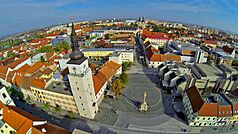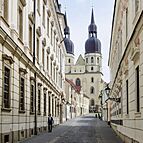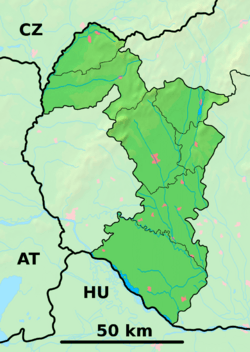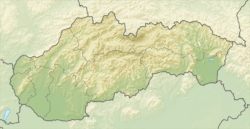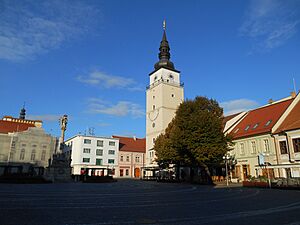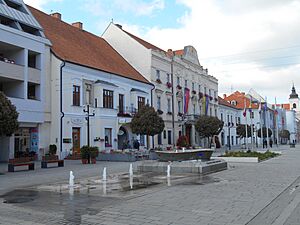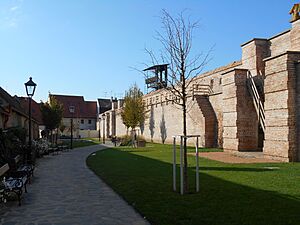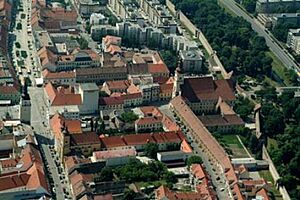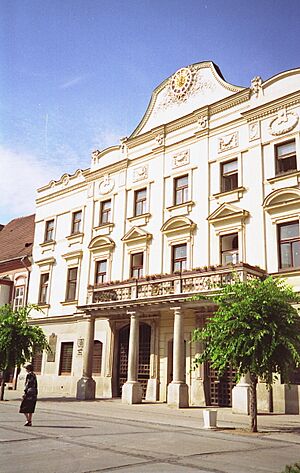Trnava facts for kids
Quick facts for kids
Trnava
|
|||
|---|---|---|---|
|
City
|
|||
|
From the top, Panoramic view of Trnava, Basilica of Saint Nicholas, Trnava Town Hall
|
|||
|
|||
| Nickname(s):
Malý Rím (Little Rome)
|
|||
| Country | |||
| Region | Trnava | ||
| District | Trnava | ||
| First mentioned | 1211 | ||
| Area | |||
| • Total | 71.54 km2 (27.62 sq mi) | ||
| (2022) | |||
| Elevation | 144 m (472 ft) | ||
| Population
(2022)
|
|||
| • Total | 62,806 | ||
| • Density | 877.91/km2 (2,273.79/sq mi) | ||
| Time zone | UTC+1 (CET) | ||
| • Summer (DST) | UTC+2 (CEST) | ||
| Postal code |
917 00
|
||
| Area code(s) | +421 33 | ||
| Car plate | TT | ||
Trnava (pronounced Tr-na-va) is a city in western Slovakia. It is about 47 kilometers (29 miles) northeast of Bratislava, located on the Trnávka river. Trnava is the main city of the Trnava Region and the Trnava District. It is also an important center for the Roman Catholic Church, having an archbishopric (a bishop's main church area).
The city has a beautiful historic center. Because of its many churches, Trnava is often called "Little Rome" (Malý Rím in Slovak). People also sometimes call it the "Slovak Rome."
Contents
- The Name of Trnava
- A Look at Trnava's History
- Geography and Climate
- People of Trnava
- Main Sights to See in Trnava
- Culture in Trnava
- Education in Trnava
- Trnava's Economy
- Getting Around Trnava
- Parks and Green Spaces
- Sports in Trnava
- Famous People from Trnava
- Fun Facts About Trnava
- Trnava's Sister Cities
- See also
The name Trnava comes from the Trnava creek. This creek's name comes from an old Slavic word, tŕň, which means "thornbush." This is because the river banks in the area used to have many thornbushes. Many towns in Central Europe have similar names, like Tarnów in Poland.
When Trnava became an important market town, it got the Hungarian name Nagyszombat. This name means "Great Saturday" and refers to the weekly markets held on Saturdays. However, the Slovak name Trnava became more common, even among German settlers.
People have lived in the area where Trnava is now since the Neolithic period, which was a very long time ago.
During the Middle Ages, Trnava became an important market town. It was located where two major trade routes met. One route went from Bohemia to Hungary, and another from the Mediterranean Sea to Poland.
The first time Trnava was mentioned in writing was in 1211. In 1238, Trnava was the first town in what is now Slovakia to be given a special town charter by the king. This charter gave the town and its people special rights. Because of this, Trnava grew from a farming area into a center for making goods, trading, and crafts.
In the early 1200s, the king of Hungary invited many Germans to live in Trnava. More Germans moved there after the Mongol invasion in 1242. Around the late 1200s and early 1300s, a large part of Trnava was protected by long city walls. The original Hungarian and Slovak market areas, along with the German settlers, lived inside these walls.
Trnava was also a place where important agreements were made. For example, in 1327, King Charles I of Hungary signed a money agreement with John of Luxemburg, the Czech King. Later, in 1360, King Louis I (who often stayed in Trnava and died there in 1382) signed a friendship agreement with Emperor Charles IV.
Hussites and Slovak People
For a while, German people were the majority in Trnava. But this changed during the Hussite campaigns in the 1400s. The Hussites were a religious group from Bohemia. In 1430, they fought and defeated the Hungarian army near Trnava. Even though the Hussites suffered many losses, they later captured the town in 1432 and used it as a base for their campaigns until 1435.
After this, the number of Slovak people in Trnava grew, and they became the main group.
Trnava became even more important after the Ottoman Empire took over most of Hungary in 1541. Trnava became the main city for the Archbishopric of Esztergom (a major church area) from 1541 to 1820. Many Hungarian people who were escaping the Turks moved to Trnava after 1541.
In the 1500s and especially the 1600s, Trnava was a key center for the Counter-Reformation in the Kingdom of Hungary. This was a movement to strengthen the Catholic Church. Archbishop Nicolaus Olahus invited the Jesuits (a Catholic order) to Trnava in 1561 to improve the schools. He also opened a seminary in 1566. In 1577, a priest named Nicolas Telegdi started a book-printing house in the town.
The first Catholic Bible translated into Hungarian was also finished in Trnava by the Jesuit György Káldi, who was born there. The 1600s also saw many uprisings against the Habsburg rulers. These revolts affected Trnava.
Because Trnava became a major center for the Catholic Church, it earned the nickname "A Little Rome." People saw it as a smaller version of Rome, which is the center of the Catholic Church worldwide.
The Jesuit Trnava University (1635–1777) was the only university in the Kingdom of Hungary at that time. It was founded by Archbishop Péter Pázmány. This university was created to support the Counter-Reformation, but it quickly became important for Slovak education and literature. Many teachers and half of the students were Slovaks.
From the late 1700s, Trnava became a center for the Slovak National Revival. This was a time when Slovaks worked to develop their language and culture. The first standard version of the Slovak language (created by the priest Anton Bernolák in 1787) was based on the Slovak dialect spoken in the Trnava region.
In 1820, the main church office moved back to Esztergom, and Trnava was no longer the main religious center of the historic Kingdom of Hungary.
However, the town's importance grew again when it was connected to Bratislava by a horse-drawn railway. This was the first railway line in the Kingdom of Hungary, starting in 1840. The railway reached Trnava in 1846.
After the Austro-Hungarian compromise in 1867, Trnava became a self-governing urban district. During this time, Slovak national groups like Matica slovenská were stopped or banned. But the St. Adalbert Association was founded in Trnava in 1870. This group published Catholic books and became a very important Slovak language organization until 1918.
In the 1800s and early 1900s, the town grew beyond its old city walls. Some parts of the wall were taken down, but most of it is still standing today. In 1873, the railway line from Bratislava to Trnava was rebuilt for steam trains, which helped modernize the town. New factories were built, including a large sugar factory and a car factory.
After Czechoslovakia was formed in 1918, Trnava became one of the most industrial towns in the country. During World War II, Soviet troops entered Trnava on April 1, 1945.
In 1977, Pope Paul VI made Trnava the center of a separate Slovak archbishopric. This was important because it meant Slovakia became independent from Hungary in church matters for the first time in centuries. Even though the main seat of the archbishopric moved to Bratislava in 2008, Trnava still has its own archbishopric.
After Slovakia became an independent country in 1993, Trnava became the capital of the new Trnava Region in 1996.
Geography and Climate
Trnava is located about 146 meters (472 feet) above sea level. It covers an area of about 71.5 square kilometers (27.6 square miles). The city is in the Danubian Lowland on the Trnávka river. It is about 45 kilometers (28 miles) northeast of Bratislava. The closest mountains are the Little Carpathians to the west.
Trnava has a continental climate with four clear seasons. This means it has warm summers and cold winters.
| Climate data for Trnava (observed at Piešťany) | |||||||||||||
|---|---|---|---|---|---|---|---|---|---|---|---|---|---|
| Month | Jan | Feb | Mar | Apr | May | Jun | Jul | Aug | Sep | Oct | Nov | Dec | Year |
| Mean daily maximum °C (°F) | 2 (35) |
4 (40) |
10 (49) |
16 (60) |
21 (70) |
24 (75) |
26 (79) |
26 (79) |
21 (70) |
15 (59) |
7 (45) |
3 (37) |
15 (58) |
| Mean daily minimum °C (°F) | −4 (25) |
−3 (26) |
0 (33) |
4 (40) |
9 (49) |
12 (54) |
14 (56) |
14 (57) |
10 (50) |
6 (43) |
2 (35) |
−2 (28) |
5 (41) |
| Average precipitation mm (inches) | 35.1 (1.38) |
33.4 (1.31) |
37.2 (1.46) |
37.0 (1.46) |
60.7 (2.39) |
64.8 (2.55) |
60.5 (2.38) |
57.3 (2.26) |
56.7 (2.23) |
41.0 (1.61) |
48.4 (1.91) |
47.2 (1.86) |
579.3 (22.8) |
| Source: MSN Weather | |||||||||||||
| Historical population | ||
|---|---|---|
| Year | Pop. | ±% |
| 1970 | 41,676 | — |
| 1980 | 60,750 | +45.8% |
| 1991 | 68,737 | +13.1% |
| 2001 | 70,286 | +2.3% |
| 2011 | 66,358 | −5.6% |
| 2021 | 63,803 | −3.9% |
| Source: Censuses | ||
Trnava's growth is linked to early settlers who spoke a Romance language. In 1238, a law allowed people to move freely to Trnava, which helped the town grow. For a long time, German settlers played a big role in Trnava's society, trade, and government.
However, the number of German people decreased after the Hussite army took over the town (1432-1435). Slovak people had always lived in Trnava and worked to have a say in the town's government. In 1486, King Matthias Corvinus helped solve conflicts between Germans and Slovaks. By this time, Slovak was already the main language in the town.
After the Battle of Mohács in 1526, more Hungarian families moved to Trnava. To keep peace, Ferdinand I ordered that Slovaks, Germans, and Hungarians should all have equal representation in the town's government starting in 1551. In the 1500s, Trnava had about 2,000-3,000 citizens. By the end of the Middle Ages, about 5,000 people lived in the town and its surrounding areas.
According to the 2001 census, Trnava had 70,286 people. In 2018, the population was 65,207.
Main Nationalities (2001 census):
- Slovaks (96.89%)
- Czechs (0.79%)
- Romas (0.27%)
- Hungarians (0.21%)
Even in the Middle Ages, Trnava was famous for its beautiful Gothic buildings. These included churches like St. Nicolas's Church and St. Helen's Church. There were also several monastery complexes, such as those for the Clarist, Franciscan, and Dominican orders.
In the Renaissance period (1500s), a town tower was added to Trnava's skyline. Nicolas Oláh ordered the building of a seminary and an Archbishop's Palace. The town's walls were also rebuilt to be stronger, to protect against the approaching Turkish threat.
The 1600s saw the building of the Paulinian Church. Trnava slowly changed to the Baroque style. The building of the St. John the Baptist Church and the university campus started a building boom. Many other buildings were also renovated in the Baroque style. The Holy Trinity Statue and the statues of St. Joseph are also from this period.
The District hospital was built in 1824. The city's theater started being built in 1831. Both of Trnava's synagogues, which have special designs, were built in the 1800s. The Synagogue Status Quo Ante now holds the Jána Koniareka art gallery.
Trnava has a rich cultural history.
- In literature: The scholar János Zsámboky wrote a Latin poem about his hometown, Trnava, in 1564. The Slovak author Jožo Nižnánsky wrote an adventure novel called Trnava, ruža krvavá (Trnava The Bloody Rose) in 1938. This book describes Trnava during Rákóczi's War of Independence. Juraj Červenák set his mystery novel Lovec čertov (The Devil Hunter) in Trnava.
- In cinema: The 1957 Slovak film Posledná bosorka (The Last Witch) takes place in Trnava in the 1700s.
Theatre and Museums
- Ján Palárik Theatre is a professional Slovak-language theater company.
- Galéria Jána Koniarka (Ján Koniarek Gallery) is an art gallery.
- Západoslovenské Múzeum (West Slovak Museum) is a regional museum. It focuses on local history and culture. It also has special collections on bells, brick-making, and invertebrates (animals without backbones). Its main building is in a former Clarist monastery.
Music
- The Tirnavia choir is a well-known singing group from Trnava.
Other Cultural Spots
- Kultúrne centrum Malý Berlín is an independent cultural center. It hosts many events like theater shows, concerts, film screenings, and discussions.
Trnava is home to two universities:
- University of Trnava (the modern one) has over 7,000 students.
- University of Ss. Cyril and Methodius has over 6,800 students.
The city has nine public primary schools and one religious primary school. In 2006, over 5,400 students were enrolled in these schools. For older students, there are four high schools (gymnasia) with about 2,100 students. There are also seven specialized high schools and six vocational schools.
- The Materiálovotechnologická fakulta Slovenskej technickej univerzity v Bratislave so sídlom v Trnave (Faculty of Materials Science and Technology in Trnava) is part of the Slovak University of Technology. It teaches about materials engineering and has centers for advanced research.
Industry
Trnava has a long history of industry, especially in mechanical engineering. Even though an older car factory closed, Trnava became known for car-making again in 2003. This was thanks to the new Stellantis Trnava Plant.
The Stellantis Trnava Plant is a very important industrial site for the region and the country. It is the third-largest mechanical engineering company in Slovakia.
Another important company in Trnava is a branch of ZF Friedrichshafen. They make parts for cars, trucks, and industrial machines. The Boge Rubber & Plastics Group also has a factory in Trnava. They make parts to control vibrations and lightweight parts for cars.
Železničné opravovne a strojárne (ŽOS) Trnava (Railway repair shop and mechanic works) repairs and inspects train cars. They also build new freight wagons and modernize old ones.
Trnava is also home to a glass fiber factory. It was founded in 1966 and is now part of Johns Manville. In 2021, this factory was the largest glass industry company in Slovakia.
Roads
Trnava is located where two important international roads meet. One road goes from the Czech Republic to southern Slovakia. The other goes from Bratislava to northern Slovakia. The D1 motorway connects Trnava to Bratislava and other cities. The R1 expressway connects it to Nitra. A new bypass road is also being built.
Trains
The city has an important train station on the railway line between Bratislava and Žilina. Other train lines also end in Trnava.
Air Travel
While there is a small airstrip near Trnava, the closest international airports are in Bratislava and Vienna.
City Buses
Trnava has a public bus service with 16 different lines. Arriva is the main company that runs these buses.
Cycling
Trnava is one of the most bicycle-friendly cities in Slovakia. It has a city bicycle-sharing system. Trnava has a great network of cycling paths. In 2022, there were 22 kilometers (13.7 miles) of cycling routes in use. Another 25 kilometers (15.5 miles) were being planned. The city plans to have around 120 kilometers (75 miles) of cycling paths in total.
Parks and Green Spaces
Trnava has many lovely parks and open areas for people to enjoy.
- Ružový park
- Janko Kráľ Park
- Bernolákov sad
- Park of Belo IV
- Park pri Kalvárií
- Park SNP
- Univerzitný parčík
- Recreation zone Štrky
- Trnava ponds
Trnava is home to several sports clubs:
- FC Spartak Trnava, a football (soccer) club.
- HK Trnava, an ice hockey club.
- RC Spartak Trnava, a rugby football club.
- Trnava Bulldogs, an American Football club. Trnava Bulldogs
- BK Angels Trnava, a baseball club. BK Angels Trnava
- NK Slávia Trnava, a futnet club. Nohejbalový klub Slávia Trnava
Many notable people have connections to Trnava:
- Anton Bernolák (1762–1813), a priest and writer who created the first standard version of the Slovak language.
- Libor Charfreitag (born 1977), a hammer thrower.
- Zoltán Kodály (1882–1967), a Hungarian composer, who studied in Trnava.
- Louis I of Hungary (1326–1382), a King of Hungary, Croatia, and Poland, who died in Trnava.
- Anton Malatinský (1920–1992), a famous Slovak/Czechoslovak football player and coach.
- Igor Matovič (born 1973), a politician.
- Péter Pázmány (1570–1637), a Hungarian cardinal who founded the historic Trnava University.
- Mikuláš Schneider-Trnavský (1881–1958), a composer and conductor.
- Rudolf Vrba (1924–2006), co-author of the Vrba–Wetzler report.
- Alfred Wetzler (1918–1988), co-author of the Vrba–Wetzler report.
The first known complete translation of the Bible into the Slovak language, called the "Camaldolese Bible", is kept in the archives of the Trnava archbishopric.
Trnava is connected with these cities around the world:
 Balakovo, Russia
Balakovo, Russia Břeclav, Czech Republic
Břeclav, Czech Republic Casale Monferrato, Italy
Casale Monferrato, Italy Chomutov, Czech Republic
Chomutov, Czech Republic Kharkiv, Ukraine
Kharkiv, Ukraine Novo Mesto, Slovenia
Novo Mesto, Slovenia Sangerhausen, Germany
Sangerhausen, Germany Szombathely, Hungary
Szombathely, Hungary Varaždin, Croatia
Varaždin, Croatia Zabrze, Poland
Zabrze, Poland
See also
 In Spanish: Trnava para niños
In Spanish: Trnava para niños


